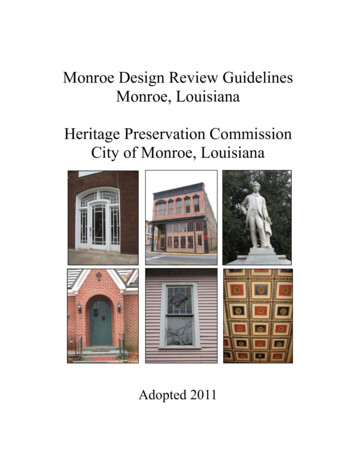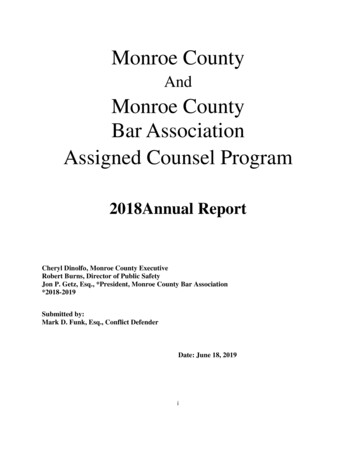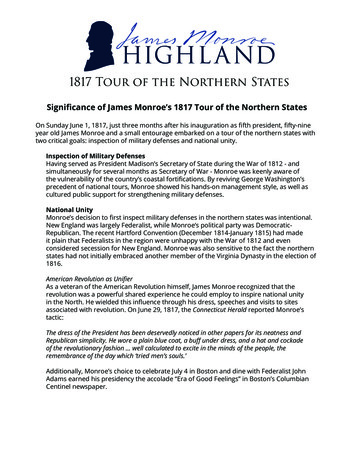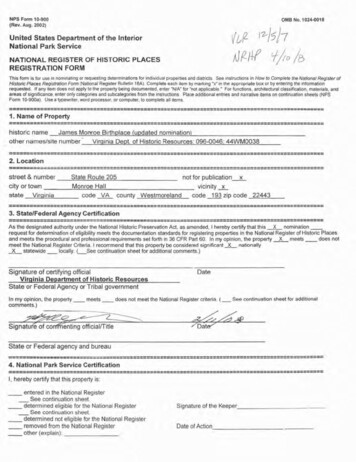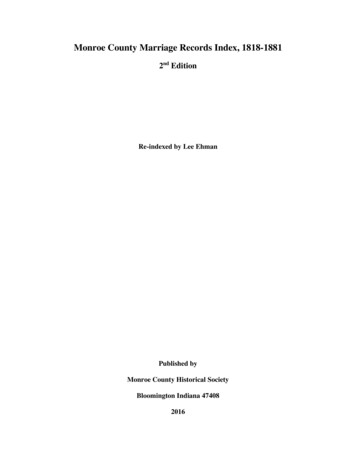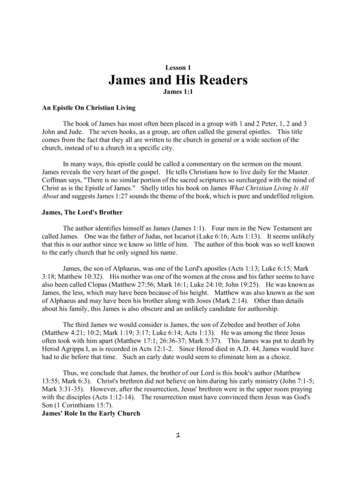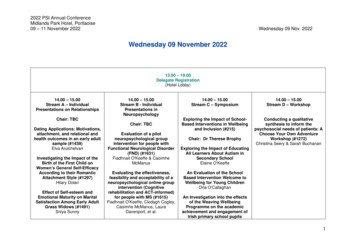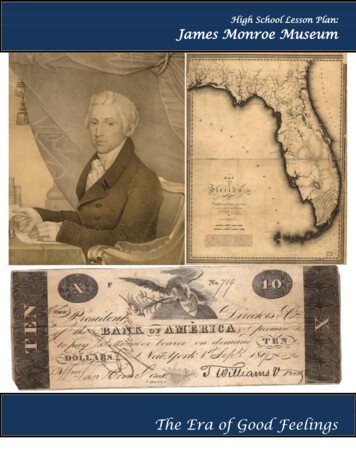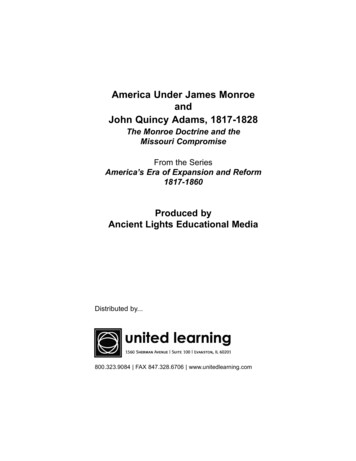
Transcription
America Under James MonroeandJohn Quincy Adams, 1817-1828The Monroe Doctrine and theMissouri CompromiseFrom the SeriesAmerica’s Era of Expansion and Reform1817-1860Produced byAncient Lights Educational MediaDistributed by.800.323.9084 FAX 847.328.6706 www.unitedlearning.com
This video is the exclusive property of the copyright holder. Copying, transmitting, or reproducing in any form, orby any means, without prior written permission from thecopyright holder is prohibited (Title 17, U.S. Code Sections501 and 506). 2003 Ancient Lights Educational Media
Table of ContentsIntroduction to the Series. . . . . . . . . . . . .1Introduction to the Program . . . . . . . . . . . .1Links to Curriculum Standards . . . . . . . . . .2Instructional Notes . . . . . . . . . . . . . . . . . . .4Pre-Test . . . . . . . . . . . . . . . . . . . . . . . . . . .4Student Preparation . . . . . . . . . . . . . . . . . .4Student Objectives . . . . . . . . . . . . . . . . . .5Introducing the Program . . . . . . . . . . . . . .5View the Program . . . . . . . . . . . . . . . . . . .5Discussion Questions . . . . . . . . . . . . . . . .5Description of Blackline Masters . . . . . . . .6Extended Learning Activities . . . . . . . . . . .7Answer Key . . . . . . . . . . . . . . . . . . . . . . . .7Script of Narration . . . . . . . . . . . . . . . . . . .11This video is closed captioned.The purchase of this program entitles the user to the right to reproduce or duplicate, in whole or in part, this teacher’s guide and theblackline master handouts that accompany it for the purpose ofteaching in conjunction with this program, America Under JamesMonroe and John Quincy Adams, 1817-1828: The Monroe Doctrineand the Missouri Compromise. This right is restricted only for usewith this program. Any reproduction or duplication in whole or inpart of this guide and the blackline master handouts for any purpose other than for use with this program is prohibited.
CLASSROOM/LIBRARYCLEARANCE NOTICEThis program is for instructional use. The cost of eachprogram includes public performance rights as long asno admission charge is made. Public performance rightsare defined as viewing of a video in the course of face-toface teaching activities in a classroom, library, or similarsetting devoted to instruction.Closed Circuit Rights are included as a part of the publicperformance rights as long as closed-circuit transmissionis restricted to a single campus. For multiple locations,call your United Learning representative.Television/Cable/Satellite Rights are available. Call yourUnited Learning representative for details.Duplication Rights are available if requested in largequantities. Call your United Learning representative fordetails.Quantity Discounts are available for large purchases. Callyour United Learning representative for information andpricing. Discounts, and some special services, are notapplicable outside the United States.Your suggestions and recommendations are welcome.Feel free at any time to call United Learningat 1-800-323-9084.
America Under James Monroe andJohn Quincy Adams, 1817-1828The Monroe Doctrine and the Missouri CompromiseFrom the Series"America's Era of Expansion and Reform, 1817-1860"Viewing Time: 14 minutes with a one-minute,five-question Video QuizINTRODUCTION TO THE SERIESThis standards-based series of programs for grades 5-9 examines the period of expansion and reform that occurred in theUnited States starting with the presidency of James Monroe in1817 up to the election of Abraham Lincoln in 1860.The five programs in this series focus on key events that shapedthe history of the United States from 1817 to 1860. Major topics examined are: United States expansion and how it affected American Indiansand foreign powers. How industrialization, immigration, expansion of slavery, andwestward movement changed the lives of Americans and ledtoward regional tensions. The extension, restriction, and reorganization of Americanpolitical democracy. The sources and character of cultural, religious, and socialreform movements in the antebellum period.INTRODUCTION TO THE PROGRAMAmerica Under James Monroe and John Quincy Adams,1817-1828: The Monroe Doctrine and the Missouri Compromise presents the following topics:1. Defining America's Boundaries, 1817-1819: The SeminoleWar and the Adams-Onis Treaty2. The Missouri Compromise, 18201
3. Mexican Independence and the Opening of the Santa FeTrail, 18214. The Monroe Doctrine, 18235. The Election of John Quincy Adams and the Founding ofFort Vancouver, 1824-18256. Implementing the "American System": The Chesapeake andOhio Canal and the "Tariff of Abominations," 1828LINKS TO CURRICULUM STANDARDSThe series of which this program is a part is correlated to theU.S. National History Standards, listed below.(www.sscnet.ucla.edu)U.S. National History Standard 1United States Territorial Expansion between 1801 and 1861,and how it affected relations with external powers and NativeAmericansStandard 1AThe student understands the international background and consequences of the Louisiana Purchase, the War of 1812, and theMonroe Doctrine.Standard 1BThe student understands federal and state Indian policy and thestrategies for survival forged by Native Americans.Standard 1CThe student understands Manifest Destiny, the nation's expansion to the Northwest, and the Mexican-American WarU.S. National History Standard 2How the Industrial Revolution, increasing immigration, therapid expansion of slavery, and westward movement changedthe lives of Americans and led to regional tensions.2
Standard 2AThe student understands how the factory system and the transportation and market revolutions shaped regional patterns ofeconomic development.Standard 2BThe student understands the first era of American urbanization.Standard 2CThe student understands how antebellum immigration changedAmerican society.Standard 2DThe student understands the rapid growth of "the peculiar institution" after 1800 and the varied experiences of AfricanAmericans under slavery.Standard 2EThe student understands the settlement of the West.U.S. National History Standard 3The extension, restriction, and reorganization of politicaldemocracy after 1800Standard 3AThe student understands the changing character of Americanpolitical life in "the age of the common man."Standard 3BThe student understands how the debates over slavery influenced politics and sectionalism.U.S. National History Standard 4The sources and character of cultural, religious, and socialreform movements in the antebellum periodStandard 4aThe student understands the abolitionist movement.3
Standard 4bThe student understands how Americans strived to reform society and create a distinct culture.Standard 4cThe student understands changing gender roles and the ideasand activities of woman reformers.INSTRUCTIONAL NOTESBefore presenting this lesson to your students, we suggest thatyou preview the program, review the guide, and the accompanying Blackline Master activities in order to familiarize yourself with their content.As you review the materials presented in this guide, you mayfind it necessary to make some changes, additions or deletionsto meet the specific needs of your class. We encourage you todo so; for only by tailoring this program to your class will theyobtain the maximum instructional benefits afforded by thematerials.PRE-TESTPre-Test is an assessment tool intended to gauge student comprehension of the objectives prior to viewing the program.Explain that they are not expected to get all the answers correct.You can remind your students that these are key concepts thatthey should focus on while watching the program.STUDENT PREPARATIONSet up a Learning Center with images relevant to the topics presented in this program such as:DA map of slave and free states around the time of theMissouri Compromise. This map could include the Adam-OnisTreaty boundary lines and the new 1818 boundary between theUnited States and Canada.4
D Pictures of Fort Vancouver, Bent's Fort, and the Chesapeakeand Ohio Canal.D A map of the Chesapeake and Ohio Canal and the ErieCanal.D A map of the Santa Fe Trail.D A map of North and South America showing former colonies and the dates of their independence for the MonroeDoctrine.STUDENT OBJECTIVESAfter viewing the program and completing the follow-up activities, students should be able to: Define the Missouri Compromise. Define the Monroe Doctrine. Explain the goals and outcomes of the "Tariff of Abominations." Describe the results of the Adams-Onis Treaty.INTRODUCING THE PROGRAMDuplicate and administer Blackline Master #1, Pre-Test. Remind your students that they are not expected to know all theanswers. Suggest that they use these questions as a guide fortaking notes on the key concepts while viewing the program.VIEW THE PROGRAMRunning Time: 14 minutes plus a one-minute, five-questionVideo Quiz.Hand out Blackline Master #3, Video Quiz.DISCUSSION QUESTIONSAfter viewing the program, you may find it helpful to discusskey concepts as a class. The following questions/statementsmay prove to be useful. You may also choose to use these topics to begin a discussion prior to viewing the program.5
1. How did the other nations of the Western Hemisphere viewthe Monroe Doctrine when it was first made public? How is itviewed by these nations today?2. Discuss the Cuban Missile Crisis and how it relates to theMonroe Doctrine.3. Discuss the system of canals that were built in the early 19thcentury and how it was used to move materials.4. Discuss how tariffs are used by the United States today toprotect industries such as steel making.5. Discuss the meaning of "free trade" and "free trade agreements" such as NAFTA.DESCRIPTION OF BLACKLINE MASTERSBlackline Master #1, Pre-Test, is an assessment tool intendedto gauge student comprehension of the objectives prior to viewing the program.Blackline Master #2, Post-Test, is an assessment tool to beadministered after viewing the program and completing additional activities. The results of this assessment can be comparedto the results of the Pre-Test to determine the change in studentcomprehension before and after participation in this lesson.Blackline Master #3, Video Quiz, is intended to reinforce thekey concepts of the program following the presentation of theprogram. Student awareness that a Video Quiz will be givenalso helps promote attention to the video presentation.Blackline Master #4, Crossword Puzzle, is a puzzle gamebased on information presented in the Vocabulary.Blackline Masters #5 and #6, Timeline and Activity, presentsimportant chronological events from 1816 to 1828.Blackline Masters #7 and #8, Vocabulary List and Activity,includes important names, people, places, and words relating toevents that occurred during this era in history.6
EXTENDED LEARNING ACTIVITIESField trips to historic sites are the best way to savor the flavorof America's early days. Research papers, oral reports, newsreports, or PowerPoint presentations could be done on the following subjects: Biographical sketches of John Quincy Adams and JamesMonroe Examples of putting the principals of the Monroe Doctrineinto effect (the Cuban Missile Crisis, for example). America's canal-building era: How the canals were built andhow the system worked. The "American System" as first proposed by Republicans in1816: How it was implemented and how it shaped the course ofAmerican history. The four-way election of 1824 and how John Quincy Adamsbecame President. The role of the Santa Fe Trail in American history. A brief history of Fort Vancouver: How it was laid out andhow it functioned as a fur-trading outpost. Andrew Jackson and the Seminole Wars.ANSWER KEYBlackline Master #1, Pre-Test1. True2. False. He issued the Monroe Doctrine warning the Europeanpowers to keep out of the Americas.3. True4. True5. False. It was very unpopular with Southerners.Blackline Master #2, Post-TestEssay QuestionsA. The Monroe Doctrine and the reasons it became AmericanPolicyDuring the first quarter of the 19th century, besides Mexico,7
almost every other important colony in Latin America gainedindependence from its mother country in Europe. However, asthis occurred, certain powerful monarchies in Europe threatened to stamp out representative governments if they developedin the old colonies. That was the reason that in 1823, PresidentJames Monroe issued his now famous policy statement calledthe Monroe Doctrine. In it, Monroe warned the European powers that he "would consider any attempt on their part to extendtheir system to any portion of this hemisphere as dangerous toour peace and safety." In other words, the Monroe Doctrinewarned the European monarchies that they could expect astrong response from the United States if they interfered withthe affairs of any independent nation in North or SouthAmerica. The ideas spelled out in the Monroe Doctrine werevery important and continue to shape American foreign policyto this very day.B. The Missouri CompromiseAs America's new boundary lines were being drawn during thepresidency of James Monroe, the nation's population reached10 million. During this period of explosive growth, new stateswere being added almost every year and the issue of slaveryincreasingly divided the nation. Mississippi was added to theUnion in 1817 as a slave state, meaning a state in which slavery was legal. The next year, Illinois was added as a free state,meaning a state in which slavery was banned. And, in 1819,Alabama was added as a slave state. At that point, the numberof free and slave states was equal. However the application byMissouri for statehood as a slave state threatened to upset thisbalance, unless the U.S. Congress took decisive action. Theleaders of the northern free states claimed Congress had theright to prohibit slavery in Missouri as well as any other newstates created west of the Mississippi River. But the leaders ofthe southern slave states strongly resisted this notion. Theyfeared that if the balance of power was shifted in favor of thefree states, slavery might be made illegal and undermine theSouth's slave-based economy.8
In 1820, Congressman Henry Clay of Kentucky helped enact alaw called the Missouri Compromise, designed to appease bothsides. This law allowed Missouri to be admitted as a save state,but it banned slavery from the entire region north of the"Missouri Compromise Line" that corresponded to its southernboundary.Fill in the blank1. House of Representatives2. Santa Fe Trail3. Tariff of Abominations4. Efficiently transport goods between the Chesapeake Bay andCumberland, Maryland, in America's interior.5. Prevent European nations from interfering with the independent nations in North and South America.6. free states7. Hudson's Bay Company8. Seminole Indians9. Maine10. slaveryBlackline Master #3, Video Quiz1. False. The Monroe Doctrine warned European nations to notinterfere with the independent nations of the WesternHemisphere.2. False. Fort Vancouver was located on the Columbia River3. True4. False. John Quincy Adams trailed in the popular vote andwas chosen President by the House of Representatives5. False. The Tariff of Abominations increased tensions between the North and South.9
Blackline Master #4, Crossword Puzzle123OJIHAS4M69C HNS A NTAFETR AIL5TQUEOASURIM O NR O E D O C TINCRINEOIFNCFYROOAOMFDE10M AS AINP7A8DEARMKEFA N D O HO C A NIRt dith E liMSOSTO-VMIOAISNNNICASOTECdliUIVOENSBlackline Master #6, Timeline Activity1. 18206. 18192. 18197. 18213. 18238. 18254.18259. 18195.182110. 1822dBlackline Master #8, Vocabulary Activity1. supplant2. Oregon Country3. barges4. slave states, free states5. electoral votes, popular vote6. American Plan7. Hudson's Bay Company8. The Great National Project9. Cumberland, Maryland; Vandalia, Illinois10. Seminoles, escaped slaves10ABMRCJML
SCRIPT OF NARRATIONAmerica Under James Monroe and John Quincy Adams,1817-1828 The Monroe Doctrine and the Missouri CompromiseJames Monroe, the man who served as America's fifthPresident, was incredibly well qualified for that difficult job.Before being elected President, Monroe had served as an officer during the Revolutionary War, as a U.S. Senator, minister toFrance, to Spain, and to Great Britain, Governor of Virginia,and both Secretary of State and Secretary of War during the Warof 1812. James Monroe spent many happy days of his life hereat Ash Lawn in the foothills of Virginia's Blue RidgeMountains. Having this place made it easy for him to spendtime next door at Monticello, the home of his good friendThomas Jefferson, the third President of the United States. Andto visit Montpelier, the nearby home of another importantfriend, James Madison, America's fourth President, whosestrong support had been essential in helping Monroe win theelection of 1816.Defining America's Boundaries 1817-1819When James Monroe assumed the office of U.S. President in1817, workmen in Washington, D.C., were still busy repairingthe White House and other government buildings damaged bythe British during the War of 1812. That year, there was troublefar to the south in the Spanish territory of East Florida. Here,U.S. troops, led by future president Andrew Jackson, were busytrying to defeat the Seminole Indians for harboring runawayslaves in their villages and for attacking American settlers justnorth of the border in Georgia. It was in response to theSeminole War that Secretary of State John Quincy Adamsoffered to buy East Florida from the Spanish. Spain acceptedthe offer, and in 1819, the Adams-Onis Treaty was signed.Under this agreement, ownership of all the lands that now makeup the state of Florida was transferred to the United States for acost of only five million dollars. But the Adams-Onis Treatywas important for another reason, because it defined a clear11
southern boundary between New Spain and U.S. territory westof the Mississippi River.In 1818, the year before the treaty with Spain was signed, anagreement had been reached between the United States andGreat Britain that established most of the U.S. boundary withBritish Canada. However, at the Oregon Country, the name forthe lands between the Rocky Mountains and the Pacific Ocean,no agreement was made and the boundary ended. Britain andthe United States agreed to share access to the Oregon Country.People of each nation would be free to trade and settle here untilthe boundary could be decided. Of course, as was typical of thatera, little importance was attached to how the Native Americansof the region would be affected after white settlers started displacing them from their ancient homelands. However, as aresult of this agreement, the United States moved a little bitcloser to becoming a nation that spanned the entire continent.The Missouri Compromise, 1820As America's new boundary lines were being drawn during thePresidency of James Monroe, the nation's population reached10 million. During this period of explosive growth, new stateswere being added almost every year and the issue of slaveryincreasingly divided the nation. Mississippi was added to theUnion in 1817 as a slave state, meaning a state in which slavery was legal. The next year, Illinois was added as a free state,meaning a state in which slavery was banned. And in 1819,Alabama was added as a slave state. At that point, the numberof free and slave states was equal. However the application byMissouri for statehood as a slave state threatened to upset thisbalance, unless the U.S. Congress took decisive action. Theleaders of the northern free states claimed Congress had theright to prohibit slavery in Missouri, as well as any other newstates created west of the Mississippi River. But the leaders ofthe southern slave states strongly resisted this notion. Theyfeared that if the balance of power was shifted in favor of thefree states, slavery might be made illegal and undermine theSouth's slave-based economy.12
In 1820, Congressman Henry Clay of Kentucky helped enact alaw called the Missouri Compromise, designed to appease bothsides. This law allowed Missouri to be admitted as a slave state,but it banned slavery from the entire region north of the"Missouri Compromise Line" that corresponded to its southernboundary.It is interesting to note that while the Missouri Compromisewas being worked out, voters in the state of Massachusettsdecided to create a new free state from northern lands that hadbeen part of Massachusetts since early colonial times. So thatwhen the state of Maine entered the Union in 1820, it balancedthe influence of the new slave sate of Missouri when it becamea state the next year.Mexican Independence and the Opening of the Santa FeTrail, 1821In 1821, the same year that Missouri became America's 24thstate, Mexico was granted independence from Spain. And, justas soon as Spain's long-time restrictions on foreign importswere lifted, a new trade route called the Santa Fe Trail wasestablished between the town of Independence in Missouri, andMexico's old city of Santa Fe, 780 miles, or 1,260 kilometers,to the west.After that, every year for the next twenty years, about 80American wagons filled with manufactured goods would makethe long and difficult journey to Santa Fe, returning along thesame route with Mexican gold, silver, furs, and mules. Thetraders would always stop here at the remote fur-trading outpostknown as Bent's Fort, which back then lay just across theArkansas River from Mexico in what is today the state ofColorado. For Bent's Fort was the only place people travelingon the Santa Fe Trail could purchase needed supplies and havetheir wagons repaired.13
The Monroe Doctrine, 1823During the first quarter of the 19th century, besides Mexico,almost every other important colony in Latin America gainedindependence from its mother country in Europe. However, asthis occurred, certain powerful monarchies in Europe threatened to stamp out representative governments if they developedin the old colonies. That was the reason, that in 1823, PresidentJames Monroe issued his now famous policy statement calledthe Monroe Doctrine. In it, Monroe warned the European powers that he "would consider any attempt on their part to extendtheir system to any portion of this hemisphere as dangerous toour peace and safety." In other words, the Monroe Doctrinewarned the European monarchies that they could expect astrong response from the United States if they interfered withthe affairs of any independent nation in North or SouthAmerica. The ideas spelled out in the Monroe Doctrine werevery important and continue to shape American foreign policyto this very dayThe Election of John Quincy Adams and The Founding ofFort Vancouver, 1824- 1825The ideas set forth in the Monroe Doctrine were actually firstproposed by Monroe's Secretary of State, John Quincy Adams.He was the son of second President John Adams and a manwho, on his own, had accomplished a tremendous amount in theUnited States government. However, in the four-way presidential election of 1824, candidate Andrew Jackson beat Adams inthe popular vote and even received 15 more electoral votes thanAdams. Even at that, Jackson still did not have enough electoralvotes to be declared the official winner and the House ofRepresentatives had to decide the contest. After the fourth placecandidate Henry Clay threw his support to Adams, the Housedeclared Adams the winner. Many Americans were outraged bytheir decision, but under the law, the way John Quincy Adamsbecame the sixth U.S. President was perfectly legal.In 1825, the year Adams took office, Great Britain made a boldmove to bolster its claim to the Oregon Country. Just to the west14
of here, along the Columbia River, Britain's Hudson's BayCompany began to construct a huge fur-trading outpost wheretoday's city of Vancouver, Washington, stands. When it wasdone, Fort Vancouver was a sprawling compound that bustledwith activity. It was comprised of big warehouses, a hospital, astore, workshops, and dwellings. The fort was visited regularlyby ocean-going ships. It rapidly became the center of trade andcivilization for the region and it played a key role in later whitesettlement of the Oregon Country.Implementing the "American System"The Chesapeake and Ohio Canal and the "Tariff ofAbominations,"1828President John Quincy Adams was a firm believer in what wascalled the American System. This was a plan first instituted byRepublicans in Congress in 1816. It required the federal government to take certain bold steps to make the United States astronger nation. A key part of this plan was to have the government make important improvements in the nation's transportation system. One of these improvements was the Chesapeakeand Ohio Canal seen here. When President John Quincy Adamsbroke ground for this canal on July 4th, 1828, it was envisionedas a "Great National Project" that would increase the speed thatmaterials could be transported between the Atlantic seaboardand the nation's interior. It connected Washington, D.C., and theGreat National Road that began at Cumberland, Maryland,which at that time was the country's main route to the westFor many years, a steady stream of barge traffic loaded withvaluable cargoes such as grain and coal moved up and down theChesapeake and Ohio Canal. However, by the time it was completed in 1850, the use of canals for transportation was alreadybeing supplanted by much faster steam-powered railroads andthe canal was rapidly becoming obsolete.The same year construction began on the Chesapeake and OhioCanal, Congress took another bold step intended to promote thenation's well-being when it passed a very high tariff, or tax, on15
imported goods. The tariff was enacted to protect the factoriesof New England from overseas competition by making foreignproducts more expensive than their American counterparts. Butthe owners of southern slave plantations hated it. They calledit the "Tariff of Abominations," abomination being a word thatmeans disgusting or loathsome. The reason they hated it wasthat a large percentage of southern agricultural products, mainly cotton, was sold overseas. In payment, instead of money,they often received finished goods, such as woven cloth. Andthe tariff on these goods was a major expense. Southernersbelieved that the owners of northern factories were growingricher at their expense. They also thought that by imposing thetariff, the federal government was interfering with their rights.Besides that, many white southerners were beginning to fearthat the government might also try to outlaw slavery itself andthat was something they would not tolerate.And so, with the Tariff of Abominations tearing away at thefabric of national unity, another election was held in whichAndrew Jackson soundly defeated John Quincy Adams for thejob of President of the United States. And with that, a new erain American history began.Video Quiz1. True or False? The Monroe Doctrine placed high tariffs onforeign goods.2. True or False? Fort Vancouver was located on the OhioRiver.3. True or False? The Santa Fe Trail opened after Mexicogained independence from Spain.4. True or False? John Quincy Adams became President afterwinning a very small majority of the popular vote.5. True or False? The "Tariff of Abominations" helped improvenational unity in the United States.16
America Under James Monroe and John Quincy Adams, 1817-1828 The Monroe Doctrine and the Missouri Compromise From the Series America s Era of Expansion and Reform 1817-1860 . Television/Cable/Satellite Rightsare available. Call your United Learning representative for details. Duplication Rightsare available if requested in large
